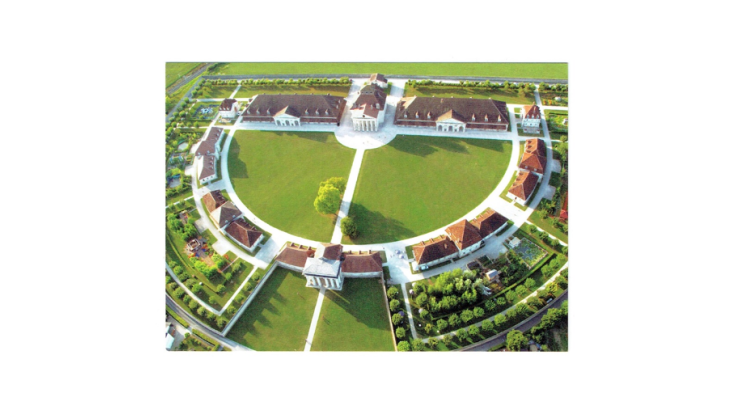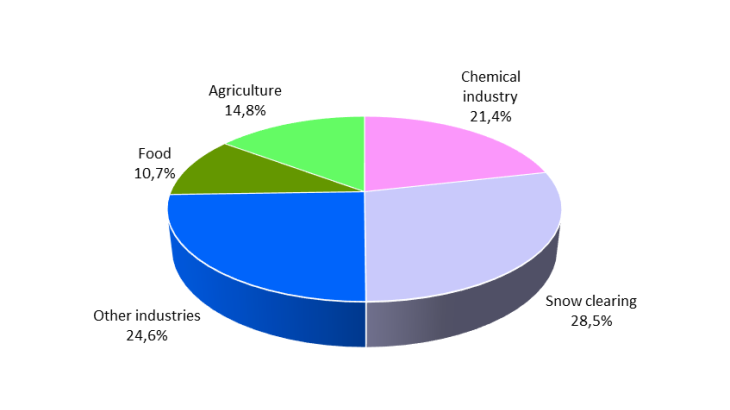A precious commodity and a currency
In the Neolithic period, animal domestication, the development of livestock farming and crop production led human societies to settle down. Eating habits started to change and it became essential to find techniques to ensure food preservation. By preventing the development of bacteria through dehydration, salt became a precious commodity.
Very early on in history, it was a currency of exchange for trade. In ancient Rome, it served as a means of compensating soldiers, which is the origin of the word "salary", from the Latin salarium. Coveted by rulers, it also became a means of collecting revenue, in the form of taxes. It was exploited and sold under state monopolies, which were important sources of revenue for public finances. In the Middle Ages, the “gabelle” (salt tax) was introduced in France and was only abolished under the Revolution, while Napoleon reinstated a salt tax that lasted until ... 1947.
In Salins, today Salins-les-Bains in the Jura, the Great Saltworks was a real fortress in the city, better protected than a cash centre of the Banque de France, with an outer wall, fortifications, towers and citadels. A single access controled entries and exits and the employees had their pockets sewn to prevent them from carrying away some precious grains of salt.
Salt mining and forestry in Franche-Comté
Although it always has marine origins, salt comes in different forms. On the coast, it is harvested in the salt marshes, thanks to the water’s evaporation under the effect of the sun and the wind. On the continent, there are fossilised marine salts, mine salts and gem salts (from the Latin gemma, gemstone), extracted from underground deposits. They result from the evaporation of former inland seas or from the runoff of rainwater on the rocks, which carried mineral salts to the subsoil for millions of years. The underground deposits of Franche-Comté date back more than 200 million years before our era. The salt layers thus formed, as in the region of Salins (Jura), can be very deep (up to 3,000 meters deep) and more than 100 meters thick.
Mining underground deposits is more difficult and therefore more costly than salt marshes. It requires digging galeries and wells in the subsoil to extract the salty water (brine) and bring it up to the surface by a pumping system. It is then wood-heated in tanks until the water evaporates and the salt cristalises, a process referred to as "ignigen" (produced by combustion). The vast forests of Franche-Comté are a valuable asset: in the 18th century, the forest surface area devoted to the Salins saltworks represented approximately 23,000 hectares, i.e. a square of 15 by 15 km.
The saltworks of Arc-et-Senans: the audacious project of an ideal city
After the conquest of the Franche-Comté by Louis XIV in 1674, Salins became a royal manufactory. A century later, the site of Arc-et-Senans, near Salins, was chosen by Louis XV to build new saltworks. It was necessary to increase the production of salt, notably following Switzerland’s increased demand for the production of cheese, and the saltworks of Salins lacked forest resources and space. The chosen site was close to the Loue river and to the Chaux forest. In addition, it communicated with the Mediterranean through the Dôle Canal and with the North Sea through the Rhine.
The architect Claude-Nicolas Ledoux was appointed Commissioner of the saltworks of Lorraine and Franche-Comté and was entrusted with the project, adopted by Louis XV in 1774. This architecturally ambitious ensemble opens up on a vast semicircular space surrounded by ten buildings perfectly aligned in a crescent, not only for reasons of cosmic symbolism, but also to reduce distances and facilitate the supervision of employees (up to 80).
The ensemble reflects the ideal of a model factory in the Age of Enlightenment, ensuring a rational and hierarchical organisation of work. It includes the operating buildings, a guard post, a prison, an oven, a wash house, the director's house who lived on the site with all the staff, two residential buildings for the employees, a farriery, a cooperage and gardens. It is an independent city, completed in 1779.
To supply the saltworks with saltwater from Salins, a pipeline was built and buried underground. It consisted of fir trees, hollowed out and fitted into each other, over 21 km and with a vertical drop of more than 143 m. Wood was used in preference to other materials because it is not corroded by salt. This "brine pipeline" carried 135,000 litres of brine a day. It was watched and guarded by 10 guard posts along its route, known as the "Path of the Gabelous", the customs officials responsible for guarding the salt and collecting the salt tax. This did not prevent losses of about 30% over the length of the pipeline due to leaks or theft. Annual salt production did not exceed 40,000 quintals, two-thirds of the initial target and half the production of Salins (“De pierre et de sel, les salines de Salins-les-Bains”, Ivan Grassias et al., 2006).
Overall very dynamic until 1870, the Franche-Comté salt industry started to decline at the end of the 19th century, as it came into competition with sea salt transported by rail. The saltworks of Arc-et-Senans closed in 1895, those of Salins-les-Bains in 1939. Today, they are both recorded on UNESCO’s World Heritage List. They welcome nearly 200,000 visitors a year, not counting special events (exhibitions, concerts, seminars in Arc-et-Senans), a figure that has increased sharply, climbing by 25% between 2016 and 2017. They rank among the top tourist attractions in Bourgogne-Franche-Comté, constituting a fine example of the transformation of an industrial heritage into an economic and cultural site.
Changes in the use of salt
For a long time considered as essential for the preservation of food, salt contributed to the development of the offshore fishing of herring (in the North Sea and Baltic Sea) and cod (Newfoundland) in the Middle Ages and in the 16th century. This method of preservation was then gradually replaced by cold storage. Salt continues to be used for human consumption (declining) and animal consumption, handicrafts (tannery), industry (soap and cosmetics, glass, stationery, metallurgy, electroplating), chemistry, hydrotherapy (see chart). Despite being controversial, and pending the development of substitute products, it is also widely used, to varying degrees from one year to the next depending on weather conditions, to prevent the roads from being covered in ice (up to -8°C) and to facilitate the removal of snow. Including in Bourgogne-Franche-Comté!

